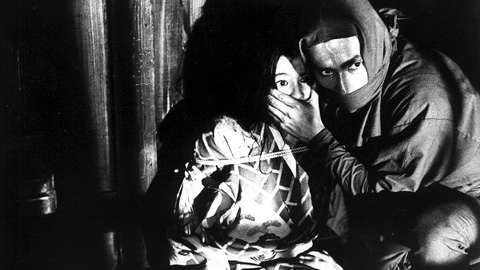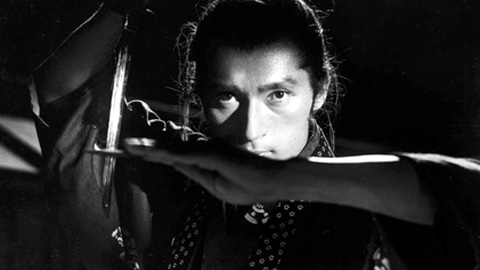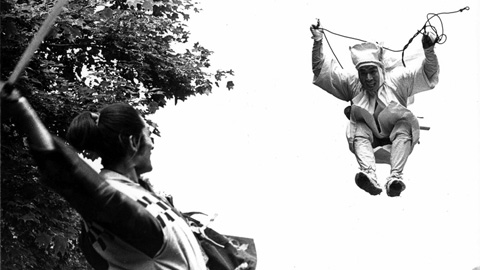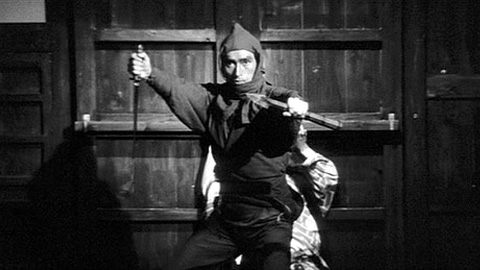Samurai Spy
- Year
- 1965
- Original title
- Ibun Sarutobi Sasuke
- Japanese title
- 異聞猿飛佐助
- Director
- Cast
- Running time
- 100 minutes
- Published
- 28 September 2011




by Nicholas Rucka
"Any discussion leads to war," says spy Sasuke Sarutobi (Takahashi) to his future fiancée Omiyo (Yoshimura). The time is 1614 and the uneasy peace after the battle of Sekigahara has left Kanto, which is controlled by the Tokugawa clan, and Kansai, the realm of the Toyotomi clan, in a purgatory of political intrigue, back-room dealing, and double-crosses. War could break out at any point and the tension is palpable.
Masahiro Shinoda's Samurai Spy tells the story of good guy Sasuke Sarutobi and his hunt for Tatewaki Koriyama, a former lieutenant in the Tokugawa clan, who has defected to the Toyotomi clan. When the story begins, Sasuke is not sure about which side to align with. Being someone who has seen too much warfare in his time, Sasuke values any peace, no matter how perilous it truly is. But it seems that he is too good at being a spy and through various external circumstances, he is forced into finding Tatewaki; if not for the tough justice that the Tokugawa clan demands of a traitor, then as an act of charity as requested by the Toyotomi clan, Tatewaki's Christian convert son and his remorseful elderly father. But in this uncertain time, people are not to be trusted and agreements and pacts can shift as quickly as the wind.
Along Sasuke's journey, mysterious, white cloaked Sakon Takatani (Tanba) and his band of black-clad Yagyu ninjas seem to appear whenever Sasuke most needs them (and eventually, least needs them). Sasuke can't figure out why Sakon and the ninjas would have an interest in him, but he does know that it is only a matter of time before the truth is discovered - and that might spell his own death. As people are murdered left and right and clan allegiances shift and then solidify, the fog of war begins to roll in, culminating in a showdown that is at one time both bloody and poetic and a precursor to the Osaka winter war.
In 1965, Russia and the US were in the thick of the cold war. The low simmering conflict would periodically bubble into moments of tense brinksmanship wherein each nation would wait for the other to either blink, or make the first strike. Masahiro Shinoda talks about how he was interested in the duality of this conflict: how there could be such a mess of political intrigue that could terminate so many lives, while also offering, as a result, a tense peace.
In Shinoda's world, nothing is clear and the violence is often abstracted, shot from afar, or staged in such a way that the logicality is suspect. We're not meant to understand a lot of what goes on in Samurai Spy. The plot is a twisting labyrinth with a large cast of characters whose names are often similar. Likewise, the shooting style is inconsistent: at times it is jarring, beautiful, experimental, playful, abstract, conventional, and just about everything else. Clearly Shinoda was studying the French nouvelle vague, but Samurai Spy seems to also to be a response, as he says, to the strict rules of bright and cheery filmmaking at Shochiku. He was young and full of piss and vinegar; no one was going to tell him what to do.
"I must stand opposed... In all of this filth and ugliness, to anything that stands in opposition to a life filled with health and goodness," says Sasuke again to Omiyo. While ostensibly the reason why Sasuke ends up siding with Toyotomi, I would posit that this is Masahiro Shinoda's anti-war stance. Samurai Spy is purposefully set during a particularly interesting time in Japanese history (and rarely explored, I might add) and the relevance to the 1965 geo-political state is intentional.
In 1965, it was unclear which ideology (communism or capitalism) would ultimately triumph among nations. Shinoda, it seems, is withholding judgment as to which is the best. I don't mean this in a literal sense, but when Sasuke has his showdown at the end, amidst the 'fogs of war,' his nemesis is no more or less a killer than Sasuke has been throughout the movie. I purposefully don't want give away who the main bad guy is, but we do find an interesting abstraction and tension occurs in the final fight between them, because it could really go both ways. Does the fact that we've ridden along with Sasuke during the whole film truly make him our hero? I suppose it does if you take into account his love for peace and Omiyo.
Going back to the fight, it starts very far away, in an extreme wide shot: Sasuke and his nemesis are mere dots on a grassy hillside. Through an edit we move in to a standard wide shot of both characters, but suddenly, a low fog has rolled in obfuscating the action both for the viewer and for Omiyo, who waits in a panic on the sidelines. As a result of the fog and also through specific editing choices, we see very little sword action here because most of it occurs off screen (Shinoda even mutes the battle sounds). However, Shinoda makes a point of parting the fog to show us the carnage of violence. Due to this technique, we are left with the indelible message that no matter how stylized and glorious violence may appear it's actually vile. Having this on top of a story that is a twisted maze of plots, counter-plots, characters, and locations, and you are left with the impression that the precursor to warfare might not be clear, nor who is on the good versus the bad side, right and wrong; the only truth is violence. And Shinoda knows that this was as true in 1614 as in 1965: violence is a cold hard truth.